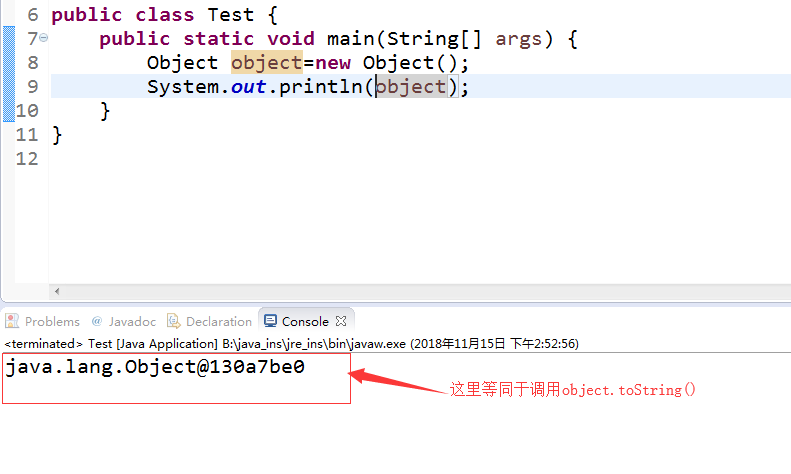一、Object类
Object类是所有Java类的根基类
如果在类的声明中未使用extends关键字指明其基类,则默认基类为Object类
public class Person { ... }
等价于:
public class Person extends Object { ... }
二、toString方法
toString()的源码:
/** * Returns a string representation of the object. In general, the * {@code toString} method returns a string that * "textually represents" this object. The result should * be a concise but informative representation that is easy for a * person to read. * It is recommended that all subclasses override this method. * <p> * The {@code toString} method for class {@code Object} * returns a string consisting of the name of the class of which the * object is an instance, the at-sign character `{@code @}', and * the unsigned hexadecimal representation of the hash code of the * object. In other words, this method returns a string equal to the * value of: * <blockquote> * <pre> * getClass().getName() + '@' + Integer.toHexString(hashCode()) * </pre></blockquote> * * @return a string representation of the object. */ public String toString() { return getClass().getName() + "@" + Integer.toHexString(hashCode()); }
Object类中定义有public String toString()方法,其返回值是 String 类型,描述当前对象的有关信息。
在打印某个对象时将自动调用该对象类中的 toString()方法。比如:
Object object=new Object(); System.out.println(object);
结果截图为:

重写toString()、如String类就重写了toString()方法,其重写的源码如下:
/** * This object (which is already a string!) is itself returned. * * @return the string itself. */ public String toString() { return this; }
当然我们也可以根据我们自己的需求去重写、此处不做实现。
三、equals()方法
equals()方法提供定义比较两个对象是否“相等”的逻辑。
Object类中 的 equals 方法 定义为:x.equals ( y ) 当 x 和 y是同一个对象(地址一样)的应用时返回 true 否则返回 false、其源码如下:
/** * Indicates whether some other object is "equal to" this one. * <p> * The {@code equals} method implements an equivalence relation * on non-null object references: * <ul> * <li>It is <i>reflexive</i>: for any non-null reference value * {@code x}, {@code x.equals(x)} should return * {@code true}. * <li>It is <i>symmetric</i>: for any non-null reference values * {@code x} and {@code y}, {@code x.equals(y)} * should return {@code true} if and only if * {@code y.equals(x)} returns {@code true}. * <li>It is <i>transitive</i>: for any non-null reference values * {@code x}, {@code y}, and {@code z}, if * {@code x.equals(y)} returns {@code true} and * {@code y.equals(z)} returns {@code true}, then * {@code x.equals(z)} should return {@code true}. * <li>It is <i>consistent</i>: for any non-null reference values * {@code x} and {@code y}, multiple invocations of * {@code x.equals(y)} consistently return {@code true} * or consistently return {@code false}, provided no * information used in {@code equals} comparisons on the * objects is modified. * <li>For any non-null reference value {@code x}, * {@code x.equals(null)} should return {@code false}. * </ul> * <p> * The {@code equals} method for class {@code Object} implements * the most discriminating possible equivalence relation on objects; * that is, for any non-null reference values {@code x} and * {@code y}, this method returns {@code true} if and only * if {@code x} and {@code y} refer to the same object * ({@code x == y} has the value {@code true}). * <p> * Note that it is generally necessary to override the {@code hashCode} * method whenever this method is overridden, so as to maintain the * general contract for the {@code hashCode} method, which states * that equal objects must have equal hash codes. * * @param obj the reference object with which to compare. * @return {@code true} if this object is the same as the obj * argument; {@code false} otherwise. * @see #hashCode() * @see java.util.HashMap */ public boolean equals(Object obj) { return (this == obj); }
jdk中提供的一些类,如String,Date等,重写了Object中的equals方法,调用这些类的equals方法, x.equals (y) ,当x和y所引用的对象是同一类对象且属性内容相等时(并不一定是相同对象),返回 true 否则返回 false。
比如,String类的equals方法显然是比较数组中的char值是否相等,源代码如下:
/** * Compares this string to the specified object. The result is {@code * true} if and only if the argument is not {@code null} and is a {@code * String} object that represents the same sequence of characters as this * object. * * @param anObject * The object to compare this {@code String} against * * @return {@code true} if the given object represents a {@code String} * equivalent to this string, {@code false} otherwise * * @see #compareTo(String) * @see #equalsIgnoreCase(String) */ public boolean equals(Object anObject) { if (this == anObject) { return true; } if (anObject instanceof String) { String anotherString = (String) anObject; int n = value.length; if (n == anotherString.value.length) { char v1[] = value; char v2[] = anotherString.value; int i = 0; while (n-- != 0) { if (v1[i] != v2[i]) return false; i++; } return true; } } return false; }
